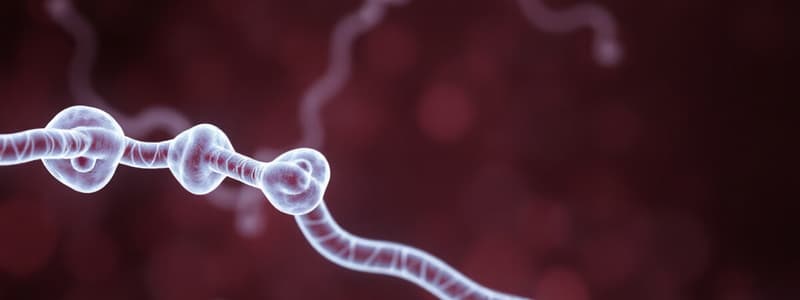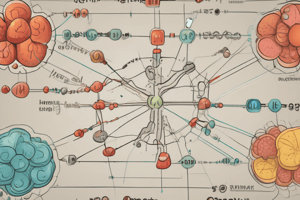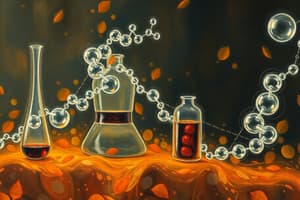Podcast
Questions and Answers
What type of sugar transformation occurs in the reaction catalyzed by phosphohexose isomerase?
What type of sugar transformation occurs in the reaction catalyzed by phosphohexose isomerase?
- Fructose to Glucose
- Glucose to Fructose
- Ketose to Aldose
- Aldose to Ketose (correct)
Which reaction represents a key regulatory step in glycolysis?
Which reaction represents a key regulatory step in glycolysis?
- Glyceraldehyde-3-phosphate Reaction
- Aldolase Reaction
- Phosphofructokinase Reaction (correct)
- Phosphohexose Isomerase Reaction
What products are formed from the splitting of Fructose 1,6-bisphosphate?
What products are formed from the splitting of Fructose 1,6-bisphosphate?
- Glyceraldehyde-3-phosphate and Dihydroxyacetone phosphate (correct)
- Phosphoenolpyruvate and ATP
- Pyruvate and NADH
- Glucose and Fructose
Which molecule is crucial for the oxidation step involving Glyceraldehyde 3-phosphate?
Which molecule is crucial for the oxidation step involving Glyceraldehyde 3-phosphate?
How many times will the reactions occur due to the presence of two 3-carbon molecules?
How many times will the reactions occur due to the presence of two 3-carbon molecules?
What is produced during the process of substrate level phosphorylation in Reaction 7?
What is produced during the process of substrate level phosphorylation in Reaction 7?
What type of reaction occurs in Reaction 8?
What type of reaction occurs in Reaction 8?
What is the product formed from 2-Phosphoglycerate in Reaction 9?
What is the product formed from 2-Phosphoglycerate in Reaction 9?
Which enzyme is responsible for converting 1,3-Bisphosphoglycerate to 3-Phosphoglycerate?
Which enzyme is responsible for converting 1,3-Bisphosphoglycerate to 3-Phosphoglycerate?
How many molecules of ATP are produced during Reaction 7?
How many molecules of ATP are produced during Reaction 7?
Which reaction stage utilizes Enolase in the conversion of 2-Phosphoglycerate?
Which reaction stage utilizes Enolase in the conversion of 2-Phosphoglycerate?
What is the overall role of ATP produced during the discussed reactions?
What is the overall role of ATP produced during the discussed reactions?
Which of the following statements regarding Reaction 10 is true?
Which of the following statements regarding Reaction 10 is true?
What is the net yield of ATP from glycolysis?
What is the net yield of ATP from glycolysis?
What happens to pyruvate during anaerobic glycolysis?
What happens to pyruvate during anaerobic glycolysis?
Which cofactor is regenerated when pyruvate is converted to lactate?
Which cofactor is regenerated when pyruvate is converted to lactate?
Which factor does NOT influence the regulation of glycolysis?
Which factor does NOT influence the regulation of glycolysis?
What effect does high ATP concentration have on phosphofructokinase?
What effect does high ATP concentration have on phosphofructokinase?
Which metabolic fate of pyruvate occurs in the presence of oxygen?
Which metabolic fate of pyruvate occurs in the presence of oxygen?
Which enzyme catalyzes the conversion of pyruvate to lactate?
Which enzyme catalyzes the conversion of pyruvate to lactate?
What happens to NADH during the conversion of pyruvate to lactate?
What happens to NADH during the conversion of pyruvate to lactate?
What is the primary energy yield from glycolysis?
What is the primary energy yield from glycolysis?
Under which conditions can glycolysis function?
Under which conditions can glycolysis function?
What is the main catabolic pathway using glucose present in all tissues?
What is the main catabolic pathway using glucose present in all tissues?
Which cell type solely relies on glycolysis for ATP production due to lack of mitochondria?
Which cell type solely relies on glycolysis for ATP production due to lack of mitochondria?
What are the end products of glycolysis under anaerobic conditions?
What are the end products of glycolysis under anaerobic conditions?
Which process allows tumor cells to generate energy preferentially?
Which process allows tumor cells to generate energy preferentially?
Which type of tissue is specifically highlighted for needing ATP quickly during intense exercise?
Which type of tissue is specifically highlighted for needing ATP quickly during intense exercise?
What major source of ATP cannot utilize fats as an energy source?
What major source of ATP cannot utilize fats as an energy source?
What is the primary function of glycolysis in the body?
What is the primary function of glycolysis in the body?
Which enzyme is responsible for the conversion of glucose to glucose 6-phosphate?
Which enzyme is responsible for the conversion of glucose to glucose 6-phosphate?
During glycolysis, how many ATP molecules are consumed in the activation stage?
During glycolysis, how many ATP molecules are consumed in the activation stage?
What is the final product of glycolysis under anaerobic conditions?
What is the final product of glycolysis under anaerobic conditions?
Which enzyme's activity is inhibited by glucose-6-phosphate, indicating a regulatory mechanism in glycolysis?
Which enzyme's activity is inhibited by glucose-6-phosphate, indicating a regulatory mechanism in glycolysis?
What is the significance of lactate dehydrogenase in muscle metabolism?
What is the significance of lactate dehydrogenase in muscle metabolism?
Which of the following statements is true regarding glucokinase?
Which of the following statements is true regarding glucokinase?
In glycolysis, the conversion of fructose 6-phosphate to fructose 1,6-bisphosphate is catalyzed by which enzyme?
In glycolysis, the conversion of fructose 6-phosphate to fructose 1,6-bisphosphate is catalyzed by which enzyme?
What are the products of one glucose molecule at the end of glycolysis?
What are the products of one glucose molecule at the end of glycolysis?
What is meant by substrate-level phosphorylation during glycolysis?
What is meant by substrate-level phosphorylation during glycolysis?
Which metabolic pathway provides an immediate source of glucose for glycolysis?
Which metabolic pathway provides an immediate source of glucose for glycolysis?
Which stage in glycolysis involves the splitting of glucose into two three-carbon molecules?
Which stage in glycolysis involves the splitting of glucose into two three-carbon molecules?
What role does NAD+ play in the process of glycolysis?
What role does NAD+ play in the process of glycolysis?
Flashcards
Glucose
Glucose
A simple sugar, a monosaccharide, essential for energy production in all living things. It's circulating in the blood and is the immediate primary energy source for cells.
Glycogen
Glycogen
A branched polymer of glucose molecules, serves as a storage form of glucose in the liver and muscles.
Glycolysis
Glycolysis
The metabolic pathway that breaks down glucose into pyruvate, generating ATP and other essential molecules.
Substrate-Level Phosphorylation
Substrate-Level Phosphorylation
Signup and view all the flashcards
Lactate Dehydrogenase
Lactate Dehydrogenase
Signup and view all the flashcards
Regulation of Glycolysis
Regulation of Glycolysis
Signup and view all the flashcards
Activation Stage of Glycolysis
Activation Stage of Glycolysis
Signup and view all the flashcards
Hexokinase
Hexokinase
Signup and view all the flashcards
Glucokinase
Glucokinase
Signup and view all the flashcards
Gluconeogenesis
Gluconeogenesis
Signup and view all the flashcards
Metabolic Pathway
Metabolic Pathway
Signup and view all the flashcards
NADH
NADH
Signup and view all the flashcards
Glycogenolysis
Glycogenolysis
Signup and view all the flashcards
Phosphofructokinase
Phosphofructokinase
Signup and view all the flashcards
Pyruvate
Pyruvate
Signup and view all the flashcards
Phosphohexose Isomerase
Phosphohexose Isomerase
Signup and view all the flashcards
Phosphofructokinase Reaction
Phosphofructokinase Reaction
Signup and view all the flashcards
Aldolase Reaction
Aldolase Reaction
Signup and view all the flashcards
Triose Phosphate Isomerase
Triose Phosphate Isomerase
Signup and view all the flashcards
Glyceraldehyde 3-phosphate Dehydrogenase Reaction
Glyceraldehyde 3-phosphate Dehydrogenase Reaction
Signup and view all the flashcards
ATP Yield from Glycolysis
ATP Yield from Glycolysis
Signup and view all the flashcards
Anaerobic Glycolysis (Lactate Fermentation)
Anaerobic Glycolysis (Lactate Fermentation)
Signup and view all the flashcards
Feedback Inhibition of Glycolysis
Feedback Inhibition of Glycolysis
Signup and view all the flashcards
Allosteric Regulation of Phosphofructokinase
Allosteric Regulation of Phosphofructokinase
Signup and view all the flashcards
Allosteric Control of Glycolysis
Allosteric Control of Glycolysis
Signup and view all the flashcards
Hormonal Control of Glycolysis
Hormonal Control of Glycolysis
Signup and view all the flashcards
What is reaction 7 and what is special about it?
What is reaction 7 and what is special about it?
Signup and view all the flashcards
What happens in reaction 8?
What happens in reaction 8?
Signup and view all the flashcards
What is produced in reaction 9?
What is produced in reaction 9?
Signup and view all the flashcards
What is special about reaction 10?
What is special about reaction 10?
Signup and view all the flashcards
What is phosphoglycerate kinase?
What is phosphoglycerate kinase?
Signup and view all the flashcards
What is phosphoglycerate mutase?
What is phosphoglycerate mutase?
Signup and view all the flashcards
What is the role of enolase?
What is the role of enolase?
Signup and view all the flashcards
What is pyruvate kinase?
What is pyruvate kinase?
Signup and view all the flashcards
What is the role of phosphofructokinase in glycolysis?
What is the role of phosphofructokinase in glycolysis?
Signup and view all the flashcards
How does ATP regulate glycolysis?
How does ATP regulate glycolysis?
Signup and view all the flashcards
What is the 'Warburg effect'?
What is the 'Warburg effect'?
Signup and view all the flashcards
What is glycolysis?
What is glycolysis?
Signup and view all the flashcards
What are the products of glycolysis under different conditions?
What are the products of glycolysis under different conditions?
Signup and view all the flashcards
Which cell types heavily depend on glycolysis?
Which cell types heavily depend on glycolysis?
Signup and view all the flashcards
What happens in the final step of glycolysis?
What happens in the final step of glycolysis?
Signup and view all the flashcards
How is glycolysis regulated?
How is glycolysis regulated?
Signup and view all the flashcards
Study Notes
Glucose Metabolism: Glycolysis & Anaerobic Metabolism
- Lecture Focus: Glucose metabolism, specifically glycolysis and anaerobic metabolism
- Lecturer: Dr. Lauren Albee
- Department: Biochemistry
- Resources: Biochemistry and Molecular Biology Chapters 11 (pp. 181-187) and 13 (pp. 210-215). Available as an e-textbook at https://bibliu.com/app/#/signinPage
- Learning Outcomes: Students should be able to:
- Draw the structures of glucose and glycogen
- Outline the metabolic events in glucose conversion to pyruvate
- Explain ATP formation from ADP via substrate-level phosphorylation
- Describe NAD+ regeneration from NADH under aerobic and anaerobic conditions, including the role of lactate dehydrogenase
- Provide an example of a control mechanism in glycolysis regulation
- Summarize the roles of glycolysis across different tissues (e.g., red blood cells)
Structure and Function of Glucose and Glycogen
- Glucose:
- Monosaccharide
- Approximately 10 g in plasma
- Osmotically active
- Immediate energy source (glycolysis)
- Synthesized from non-carbohydrate sources (gluconeogenesis)
- Glycogen:
- Polysaccharide
- Approximately 400 g in tissue stores
- Low osmolarity
- Medium-term fuel source
- Synthesis and breakdown later discussed
Glycolysis: Key Points
- Definition: Glucose (C6) to pyruvate (C3)
- Location: Cytosol (10 soluble enzymes)
- Tissues: All tissues
- Functions: Energy trapping (ATP synthesis); intermediates for fat and amino acid synthesis
Sources of Glucose for Glycolysis
- Sugars and starches from the diet
- Breakdown of stored glycogen from the liver
- Recycled glucose (from lactic acid, amino acids, or glycerol)
Glycolysis: Summary Diagram
- The diagram illustrates the ten reactions of glycolysis, featuring key enzymes, intermediates, and ATP/ADP transformations. Glycolysis is depicted as a sequence of enzymatic reactions involving glucose, glucose-6-phosphate, fructose-6-phosphate, fructose-1,6-bisphosphate, and other intermediates ultimately leading to the production of pyruvate.
Glycolysis: Stages
- Activation (using ATP): Converting glucose to fructose-1,6-bisphosphate, requiring ATP.
- Splitting the 6-carbon sugar: Breaking the 6-carbon sugar into two 3-carbon sugars, yielding glyceraldehyde-3-phosphate.
- Oxidation (removing 2H atoms): Oxidizing glyceraldehyde-3-phosphate, creating NADH and generating energy.
- Synthesis of ATP: Generating ATP through substrate-level phosphorylation.
Reactions 1, 2 &3 (activation stage)
- Reaction 1: Hexokinase or glucokinase phosphorylates glucose to glucose-6-phosphate, trapping it in the cell.
- Reaction 2: Phosphohexose isomerase converts glucose-6-phosphate to fructose-6-phosphate.
- Reaction 3: Phosphofructokinase phosphorylates fructose-6-phosphate to fructose-1,6-bisphosphate, a crucial regulatory step.
Splitting of 6C Sugar to 3C Units
- Aldolase breaks fructose-1,6-bisphosphate into glyceraldehyde-3-phosphate and dihydroxyacetone phosphate.
Reactions 4 & 5
- Aldolase catalyzes the cleavage of fructose-1,6-bisphosphate into glyceraldehyde-3-phosphate (G3P) and dihydroxyacetone phosphate (DHAP).
- Triose phosphate isomerase quickly converts DHAP into G3P.
Oxidation Step (Reaction 6)
- Glyceraldehyde-3-phosphate dehydrogenase oxidizes glyceraldehyde-3-phosphate, producing NADH and 1,3-bisphosphoglycerate.
- This reaction marks an oxidative process vital for energy generation in glycolysis.
ATP Synthesis Stages (Reactions 7, 8, 9, 10)
- Reaction 7: Phosphoglycerate kinase produces ATP from 1,3-bisphosphoglycerate.
- Reaction 8: Phosphoglycerate mutase converts 3-phosphoglycerate to 2-phosphoglycerate.
- Reaction 9: Enolase transforms 2-phosphoglycerate into phosphoenolpyruvate (PEP).
- Reaction 10: Pyruvate kinase converts PEP to pyruvate, creating a second ATP molecule.
Reaction 7 - Substrate Level Phosphorylation
- ATP is produced during this step through substrate-level phosphorylation.
- Two ATP molecules are produced for each glucose molecule.
Reaction 8 - Isomerisation
- Phosphoglycerate mutase moves the phosphate group within the substrate, maintaining the pathway.
- This reversible reaction moves a phosphate group, altering the configuration.
Reaction 9
- Enolase catalyzes the conversion of 2-phosphoglycerate to phosphoenolpyruvate by removing water molecules.
- The molecule is dehydrate to form phosphoenolpyruvate (PEP), an important link between glycolysis and other metabolic processes.
Reaction 10 - Substrate Level Phosphorylation
- Pyruvate kinase generates a second ATP molecule through substrate-level phosphorylation.
- It converts phosphoenolpyruvate (PEP) to pyruvate, releasing energy with the formation of ATP.
- Note this step is irreversible.
Summary Slide: ATP Yields
- Early stages use 2 ATP
- Later stages make 4 ATP
- Net yield = 2 ATP (plus further ATP from mitochondrial metabolism)
Anaerobic Glycolysis
- When oxygen availability is limited, pyruvate is converted to lactate.
- This process regenerates NAD+ from NADH, enabling glycolysis to continue without oxygen.
- The production of lactate during anaerobic conditions supports the regeneration of (oxidized) NAD+, essential for continuing glycolysis.
Reaction Catalyzed by Lactate Dehydrogenase
- Lactate dehydrogenase is a reversible enzyme.
- It converts pyruvate to lactate when oxygen is limited, using NADH, releasing energy for the continuation of glycolysis.
Metabolic Fates of Pyruvate
- In the absence of oxygen or mitochondria, pyruvate can be converted into lactate or ethanol.
- When sufficient oxygen and mitochondria are present, pyruvate can enter the citric acid cycle, producing ATP.
Regulation of Glycolysis
- Controlled by allosteric and hormonal mechanisms.
- One example of allosteric regulation: Phosphofructokinase regulation (ATP effects on the enzyme).
Allosteric Inhibition of Phosphofructokinase by ATP
- ATP binding to a regulatory site on the enzyme slows the reaction.
- This is a control mechanism, ensuring that glycolysis is suppressed when sufficient ATP is available.
Specialised Functions in Tissues
- Skeletal muscle: Rapid ATP production during intense exercise.
- Red blood cells: Primary pathway for ATP generation. (No mitochondria)
- Brain: Major energy source for ATP, but it cannot utilize fats as energy sources.
Summary of Glycolysis
- Main catabolic pathway for glucose utilization across all cells.
- Primarily anaerobic, a second ATP production in aerobic conditions.
- Low energy yield (2 ATP) but a crucial pathway, with generated pyruvate entering mitochondria for more significant ATP production.
- Production of intermediates for fatty acid and other metabolic processes.
Discoveries and Dilemmas
- Relevant 'extras' for further consideration, not required for immediate learning.
The Warburg Effect
- Tumour cells show high glycolytic rates, even with functional mitochondria.
- This is a hallmark feature of cancerous growth and is being intensively studied for diagnostic and therapeutic purposes.
Multiple Choice Questions (MCQs)
- Questions related to glycolysis products, relevant cell types, and ATP yields are presented. See pages 35-38 for the specific MCQ questions.
Studying That Suits You
Use AI to generate personalized quizzes and flashcards to suit your learning preferences.




